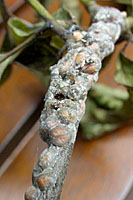Terry L. Ettinger Horticulture Consulting Services
Meeting The Needs Of Today With A Vision For The Future
Question of the Week
Magnolia Scale
 Q. Sitting under the shade of a large magnolia tree next to our swimming pool this past week we were showered by a light,
sticky mist. Looking up we saw that the tree’s branches were covered with hundreds - if not thousands - of yellowish-white
“blobs!” What are these things and why were they “spitting” at us? Also, a lot of the leaves on the tree have turned black
and appear to be dead! Are we going to lose our tree?
Q. Sitting under the shade of a large magnolia tree next to our swimming pool this past week we were showered by a light,
sticky mist. Looking up we saw that the tree’s branches were covered with hundreds - if not thousands - of yellowish-white
“blobs!” What are these things and why were they “spitting” at us? Also, a lot of the leaves on the tree have turned black
and appear to be dead! Are we going to lose our tree?
A. You can take some comfort in the knowledge that many magnolia tree owners are sharing your experience. What you’ve described is a heavy infestation of magnolia scale. It’s probably one of the ten or so most common landscape insect pests in Central New York and therefore warrants a column once every three or four years!
The “blobs” you’ve described are protective waxy covers female scale insects have secreted to protect themselves and their soon-to-be born young from predators (at right, above).
The female scales will become mature during the next several weeks then give birth to several dozen to several hundred “crawlers” from late July through the first part of August. The crawlers remain under their mother’s protective shield for a short period of time, then venture a short distance before settling on the underside of young stems throughout the tree.
Once settled the crawlers insert their syringe-like mouthparts through the bark to feed on sugar-laden sap moving through the stems. The “mist” you described is, in fact, a sticky, sugar-rich waste product of the scale’s feeding called “honeydew.”
The good news is that even heavy magnolia scale infestations rarely kill trees. In most cases, the worst consequences are that individual stems and branches will die if heavily infested for several consecutive years.
Of greater concern to many people is that the leaves on their trees turn black. This is caused by a “sooty mold” fungus growing in the honeydew covering the leaves. While it’s unsightly, sooty mold won’t injure your tree and can easily be wiped off with your fingers.
If it won’t disfigure your tree, prune out the most heavily infested branches before the middle of July to significantly reduce the number of females available to give birth. Next, a thorough application of 2% to 3% superior-type horticulture spray oil by a certified arborist or nursery professional (they have the equipment necessary to insure good coverage of large trees) between mid-August and mid-September will smother many of the crawlers. A second application of horticultural oil in late winter or very early spring - before bud break - will smother more of the overwintering scales.
Unfortunately, while this combination of tactics will reduce the severity of the current infestation, it’s likely that occasional flare-ups of this pest will need attention over time.